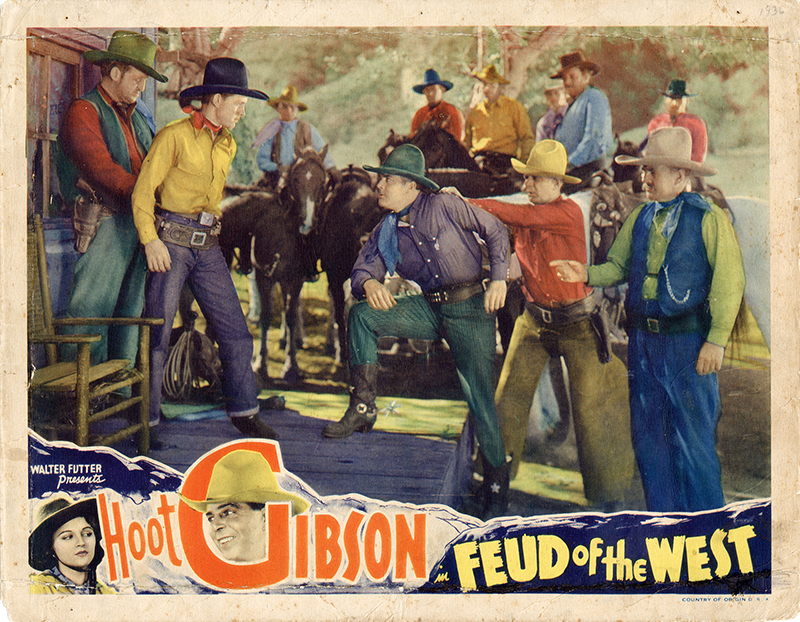Hoot Gibson stars in Harry L. Fraser's "Feud of the West" (1936), filmed on location at Vasquez Rocks and elsewhere in the Santa Clarita Valley (we don't know where).
Newhall resident and onetime child actor Buzz Barton is in the yellow shirt at left.
"Feud of the West" premiered, ironically enough, on tax day (April 15), 1936 — at a time when Gibson was going through some difficulties personally and financially
and no longer owned the Baker Ranch, which would become the Saugus Speedway. Necessity drove him to take roles in "B" (budget) pictures like this one
from Walter Futter's Poverty Row production company, Diversion Pictures Inc., which distributed its product under the states rights sytem.
"In the states rights method, producers sold their films on a territorial basis to a local salesperson who
extracted as much money as possible from the movie until the worn and scratched film print literally fell apart from sheer use.
... Copyright holders sold the actual copies of their movies; films were sold by their length, usually 10 cents per linear foot of film.
This method was ideal for short films that had brief stays in the nickelodeons. But for feature film distribution, states rights proved ineffective.
The producer made money on the initial sale of the film print, but the states rights salesperson reaped the largest rewards. Producers had slim profit margins while many films
failed to return their costs."
— Society of Independent Motion Picture Producers
"Feud of the West" is written by Russell A. Bankson (story) and Phil Dunham (screenplay). The credited cast includes Buzz Barton,
Bob Kortman,
Ed Cassidy,
Joan Barclay,
Nelson McDowell,
Reed Howes,
Lew Meehan and
Roger Williams. Uncredited cast members are Budd Buster,
Frank Ellis,
William Gould,
Allen Greer,
Lew Kelly,
Cliff Parkinson,
Francis Walker and
Slim Whitaker. Stunt performers are
Cliff Parkinson and
Francis Walker.
Edmund Richard Gibson earned the nickname "Hoot" when he worked as a messenger for the Owl Drug Co.
He was born August 6, 1892, in Tekamah, Nebraska and appeared in more than 200 films (including short
features) between 1910, when he earned $50 for his role in "The Two Brothers," and
1960, when he made an uncredited appearance in "Ocean's Eleven." Gibson did
most of his work as a silent cowboy actor between World War I and the early 1930s. He directed a bit
in 1920-21 and produced some of his own films from 1923-30. The 5'9" Hollywood giant died of
cancer on August 23, 1962, in Woodland Hills — five days before a wildfire burned down
Gene Autry's Melody Ranch in Placerita Canyon, where Gibson made some of his movies.
In addition to using the Santa Clarita Valley as a backdrop for filming, during the time he was
married to Dorothea Sally Eilers (a popular leading lady in late
silents and early talkies), he owned a ranch in Saugus now known as the Saugus Speedway. SCV historian
Jerry Reynolds writes:
"Roy Baker purchased a 40-acre tract east of Bouquet Junction during 1923, starting construction on
a rodeo arena a year later. Hoot Gibson bought the ranch and stadium in 1930, putting on shows that attracted
such stars as Tom Mix, John Wayne and Clark Gable. In 1934 Gibson sold out to Paul Hill, who ran the
Western Livestock yards and leased it to film companies for three years until a huge flood filled the home
and arena with mud and debris. (Hill) was unable to make payments, and the bank repossessed the property,
which was eventually taken over by a professor of economics at Occidental College, William Bonelli (who
started the Santa Clarita Water Co. and built one of the first local housing tracts in the late 1940s).
Today (the rodeo arena) is known as the Saugus Speedway."
LW3175: 9600 dpi jpeg from original lobby card purchased by Leon Worden.

















